 Travelers flying out of BTV will insert their ID into the CAT unit as the TSA officer views the monitor to verify whether the ID is valid. (TSA photo)
Travelers flying out of BTV will insert their ID into the CAT unit as the TSA officer views the monitor to verify whether the ID is valid. (TSA photo)
BURLINGTON, Vt. – Transportation Security Administration (TSA) officers at Burlington International Airport are now using new technology that confirms the validity of a traveler’s identification (ID) and confirms their flight information in near real time.
The two credential authentication technology (CAT) units will scan a passenger’s photo identification to verify the authenticity of the document. The system uses information from the photo identification to confirm a passenger’s flight status by cross-referencing it against the Secure Flight database.
When a traveler places their ID in the CAT unit, it informs the TSA officer if the ID is valid. Travelers who approach the TSA travel document checking podium do not have to show their boarding pass because the CAT unit verifies that the traveler is prescreened to travel out of the airport for a flight that day.
“We’re thrilled to have this technology. It is going to enhance our detection capability for identifying fraudulent documents at security checkpoints here at Burlington International,” says Bruce McDonald, TSA’s Vermont Federal Security Director. “The system also confirms the passenger’s flight status in near real time through a secured connection.”
CAT units authenticate several thousand types of IDs including passports, military common access cards, retired military ID cards, Department of Homeland Security Trusted Traveler ID cards, uniformed services ID cards, permanent resident cards, U.S. visas and driver’s licenses and photo IDs issued by state motor vehicle departments.
In addition, it is critical that travelers have their REAL ID-compliant driver’s license or other acceptable form of identification by the Oct. 1, 2021, deadline. The CAT units will not accept a driver’s license after Oct. 1, 2021, if it is not REAL ID-compliant.
A CAT unit consists of the passport reader, an ID card reader, a Federal personal identity verification ID card reader, a monitor, a stand and a UV light. Each unit costs approximately $27,000.
Burlington International isn’t the first airport in New England to receive this technology. TSA officers at Boston-Logan International airport, which has 25 CAT units, began using them in December 2019. Bradley International in Hartford also has five CAT units in operation.
TSA’s goal is to install 27 more CAT units throughout New England’s major airports by December.
